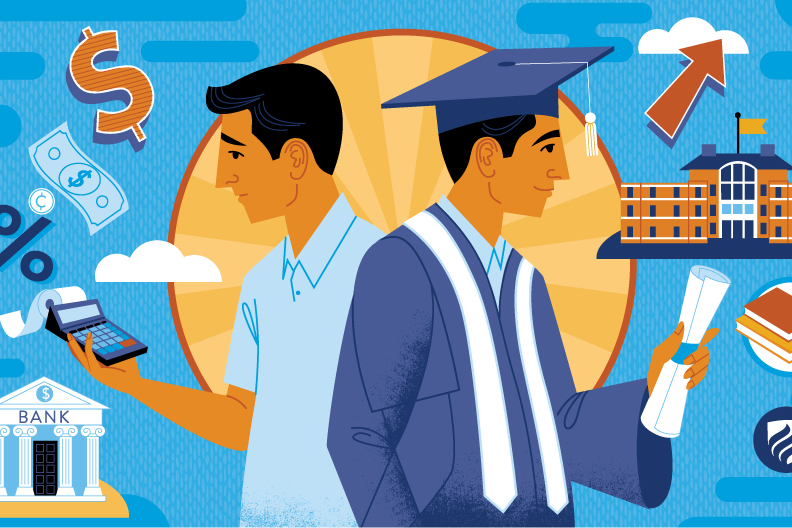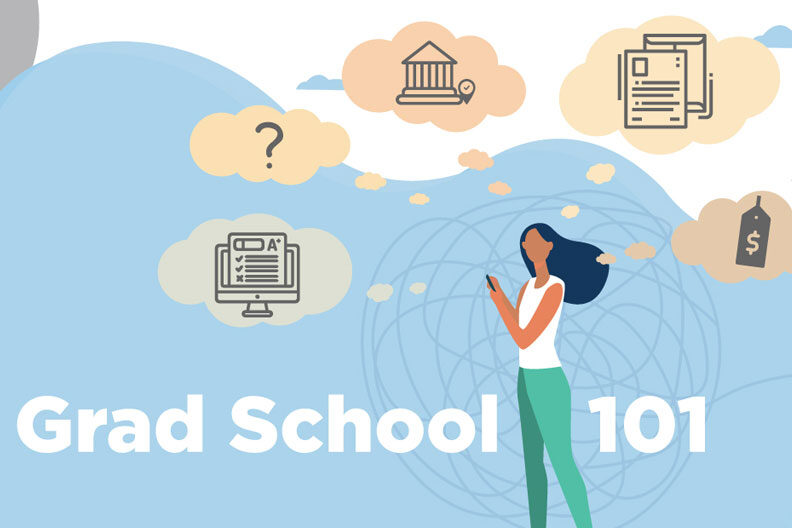How to Pay for Grad School
GRADUATE STUDIES | 6 MIN READ

On average, workers with a master’s degree earn about $10,000 more a year than their counterparts with a bachelor’s degree, according to the U.S. Bureau of Labor Statistics. And in many careers, a master’s degree is the new educational standard. The benefits of an advanced degree are immediately clear, but how to pay for grad school isn’t as clear-cut.
Many students have questions about how to finance their education. Below, we offer some answers.
But first, let’s add a little bit of context: A report by Sallie Mae shows that full-time graduate students spend an average of almost $25,000 a year on school. About a fourth is covered by the student’s earnings or savings—which leaves a hefty balance.
It’s important to look at the net cost versus the net gain, as any student financial services professional would tell you. For the student who has a career plan and a direction for when that master’s degree has been completed, the investment can pay for itself many times over in lifetime earnings and career trajectory.
How Do You Pay for a Master’s Degree?
You can pay for grad school in a number of ways besides spending money out of your own pocket:
- Institutional scholarships, apprenticeships and fellowships
- Federal aid
- Private loans
- Employer assistance, tax credits, and loan forgiveness and repayment programs
The options can become dizzying, but if you work through it step by step, you’ll be able to ease your financial worries and stay focused on your studies.
How to Pay for Grad School with Scholarships
The good news: scholarships can be need- or merit-based and are basically free money. The bad news: they are harder to come by at the graduate level than as an undergraduate. Some schools offer tuition remission and stipends for graduate students (most often Ph.D. students) who help with research, teach classes or work for a professor. Fellowships and assistantships tend to be very competitive, so plan to apply early.
Some states fund their own scholarships through the state board of education. Grants, similar to scholarships in that they do not need to be repaid, are often aimed at specific kinds of students: veterans or children of service members, first-generation students, women and minorities. Eligibility may vary by college or university so students should check with the financial aid office at their school to determine availability.
At the graduate level, scholarships are awarded for certain programs at the time of admission. They’re often based on academic performance, extracurricular activities and program-specific requirements. These scholarships can also be contingent on whether you plan to study full- or part-time.
How to Pay for Grad School with Federal Aid
More than half of graduate students answer the question “How to pay for grad school?” by taking out a loan of some kind. The first step is to fill out a FAFSA, the Free Application for Federal Student Aid you may remember from your undergraduate days. These can be submitted from October 1 of the previous calendar year (i.e., October 1, 2019, for students starting in Summer or Fall 2020) through the end of the academic year.
The FAFSA determines how much financial aid you can receive from the government. This aid can come in a few forms:
- Federal Direct Unsubsidized Stafford Loans. Sometimes called unsubsidized Stafford Loans, these have a fixed interest rate, and some have repayment plans based on your income; the maximum amount is $20,500 a year. Qualifying for these loans can depend on how you choose to study (full-time vs. part-time). Students who select a part-time program and are enrolled at least half-time at Elmhurst University can be fully financed through this loan.
- Direct Graduate PLUS Loans. PLUS loans have fixed interest rates and allow you to borrow up to the cost of your entire tuition and fees (minus any other financial aid); borrowers with a poor credit history may need a cosigner. These loans can be income-based and have longer repayment plans than most private loans.
Unfortunately, Pell Grants are limited to those pursuing a bachelor’s degree for the first time.
How to Pay for Grad School with Private Loans
Loans through banks and other financial institutions vary widely. While some may have fixed interest rates, most of the interest rates will be variable.
Students should be leery of variable-interest private loans, as interest rates can increase at any time. Plus, those loans usually don’t have the same flexible repayment rates that federal loans have.
The better your credit, the more likely you will be approved for a loan and the lower your interest rate will be. Some lenders allow you to defer payments until after you graduate, though the loans still accrue interest while you are in school.
Other Ways to Help You Pay for Grad School
- Employer assistance. Many companies provide some tuition reimbursement but check with your human resources department for information. Some employers won’t approve those benefits unless the coursework is directly applicable to your current work situation—not ideal for someone looking to change careers. Other employers may hold payment until the course is completed and your grade is posted. Again, talk with your employer for details.
- Public service options. Government programs such as AmeriCorps and Learn and Serve America offer loan forgiveness, tuition assistance and stipends for participants. Contact the specific organizations as they will be the ones dictating the terms and conditions for any graduate-level scholarships.
- Tax breaks. Students may be able to claim a portion of their education expenses through the Lifetime Learning Tax Credit, Student Interest Loan Deduction, and Tuition and Fees Deduction. Ask a tax professional to find out which, if any, of these options are available to you.
Still feeling a bit overwhelmed? The best resource you have is the financial aid office at your college or university—professionals dedicated to helping you navigate all your payment options—as you learn how to pay for grad school.
Interested in Starting Graduate School?
Complete our form to request more information!




